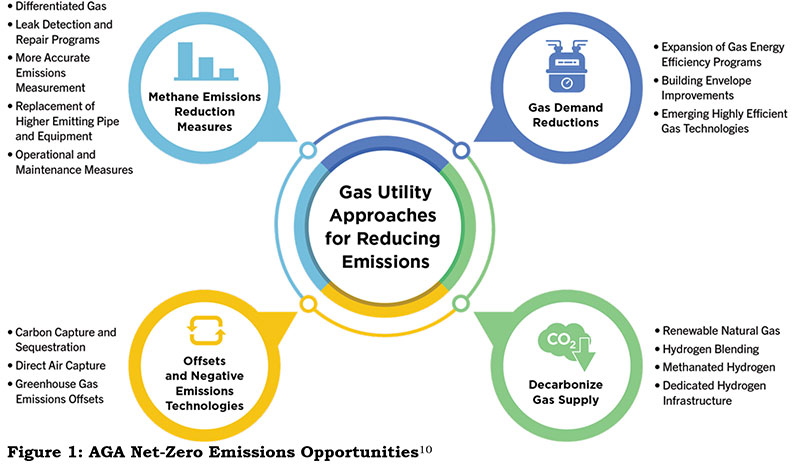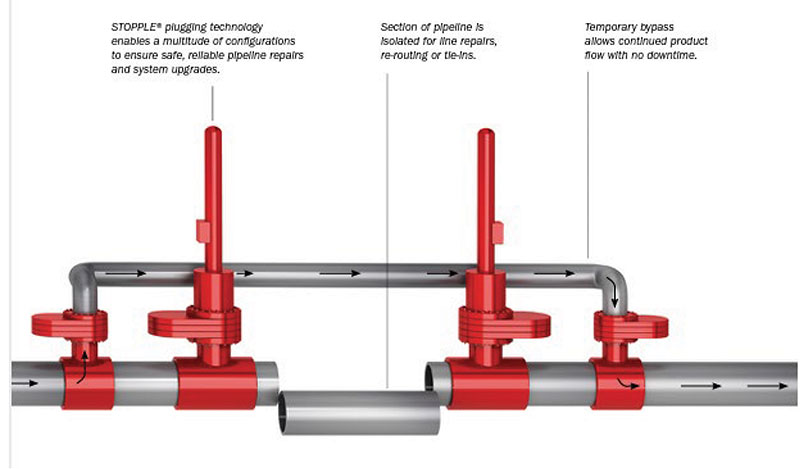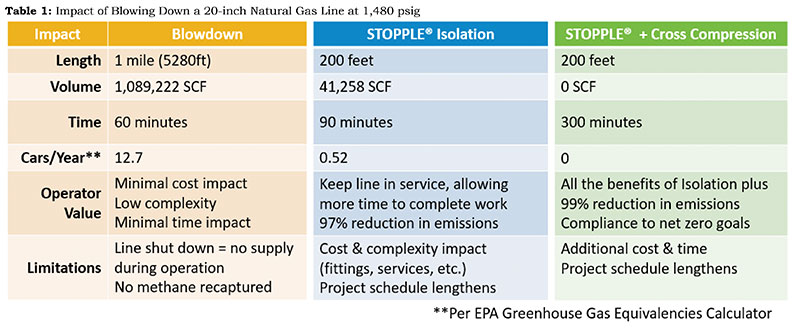June 2022, Vol. 249, No. 6
Features
Pipeline Isolation, Cross Compression Virtually Eliminate Emissions
By Aaron Madden, Market Development Manager, Strategy Execution, T.D. Williamson, USA
For corporations, countries and individuals alike, both long-range planning and daily behavior are increasingly influenced by two little words: net zero.
To meet internal commitments and improve environmental, social and governance (ESG) performance, more than 600 of the world’s 2,000 largest companies have committed to being net zero by 2050,1 which means they will remove as many greenhouse gas (GHG) emissions as possible, then compensate for any that cannot be removed.
Two-thirds of the world’s 198 countries have made this kind of promise or at least say they are thinking about doing so.
However, most of the governmental pledges are actually limited to policy commitments; only a handful of nations have legally binding net-zero targets: Sweden, Germany, France, Denmark, Spain, Hungary, U.K. and Luxembourg. A few more have passed laws committing to net zero (Japan, Korea, Canada and New Zealand) while legislation is pending in Ireland, Chile and Fiji.2
In December 2021, President Joe Biden brought the U.S. inches closer to a formal pledge when he signed an executive order saying the government will be a “net-zero contributor to the climate crisis.”3
Although the order pertains only to federally owned buildings and vehicles, it’s believed that those facilities and fleets create 15% of all U.S. carbon emissions, meaning their impact is significant. The order is also Biden’s largest effort toward making America net zero by 2050, a goal that includes having the nation’s electricity grid run entirely on renewable energy by 2035.
Considering that natural gas currently generates almost 40% of all utility-scale electricity in the U.S. – more than any other source – that’s a pretty ambitious goal, especially given the time frame.4
Transition Demand
Presidential orders aren’t the only way the U.S. is chipping away at natural gas demand in hopes of meeting climate targets. In California and New York, for example, some cities have banned natural gas connections in new construction, but this is unlikely to have the effect they seek.
After all, putting an end to gas-powered cooking, clothes drying and home heating means running appliances on electricity instead. With the existing grid unable to meet increased loads, it’s going to take even more natural gas to generate sufficient electric power, making those bans seem unproductive at best.
It’s no wonder why a number of other states, in response, have passed “preemptive laws” that prevent natural gas prohibitions.
Despite various attempts to tamp down natural gas usage, consumption in the U.S. is actually on the rise, in both residential and industrial settings. The American Gas Association (AGA) says there were 900,000 new residential customers in 2020, the largest increase since 2016.
Other factors contributing to the increase include the use of natural gas as a replacement for coal, the astonishing growth in liquefied natural gas (LNG) demand, which is expected to be up 90% by 2040 over 2021,4 and the fact that there’s no alternative to natural gas for process fuel and feedstock.
The Energy Information Administration (EIA) projects that industrial usage of natural gas will rise in 2022 to levels not seen since the 1970s.5 To meet demand, EIA says natural gas–marketed production will reach a record high 106.6 Bcf/d (3.019 Bcm/d) in 2023.6
There’s no getting around it. The world depends on natural gas, and pipelines are the safest means of transporting the energy that fuels everyday life.
Closer Eye
Of course, we can’t overlook that natural gas consumption comes with an environmental cost, or that the oil and gas industry is one of the largest sources of methane emissions. As the Environmental Defense Fund (EDF) notes, methane has more than 80 times the warming power of carbon dioxide (CO2) over the first 20 years after it reaches the atmosphere.
Even though CO2 has a longer-lasting effect, EDF says, “methane sets the pace for warming in the near term.”7
However, society is looking more closely at natural gas pipelines and the emissions associated with them than ever before. While the public once focused only on significant incidents and large product losses, today, their attention is drawn to any emission anywhere along the value chain.
While we all want to be good environmental stewards and move toward a sustainable energy future, we must be practical. As the growth in consumption suggests, there’s no point in trying to eliminate natural gas altogether.
There are decarbonization options, however.
For example, AGA presented four pathways to emissions reductions at their February 2022 Net-Zero Study Briefing, as noted in Figure 1. The briefing is a culmination of two years of investigation into how gas utilities can meet their ESG goals, including those for utility distribution infrastructure.
AGA says the approaches increase the likelihood their members will reach net-zero GHG emissions while leveraging existing infrastructure and without disrupting customer service.
Pipeline service providers are already helping with some of those efforts. Through isolation, pigging and integrity solutions, T.D. Williamson (TDW) reduces or eliminates emissions – and it’s something we’ve been doing for generations.
The Road to Net Zero
Consider pipeline isolation (Figure 2), for example.
Before advances in isolation technology such as the TDW STOPPLE system, the only way operators could repair their pipeline was to take the system out of service then blow down the entire segment between ball valves, which are typically miles apart.
Even having to blow down a 1-mile (1.6-km) stretch of a 20-inch natural gas line can have enormous consequences (Table 1). In that example, purging 1,089,222 standard cubic feet (SCF) of natural gas results in a release of more than 5,200 pounds of methane – equivalent to the CO2 produced by 12.7 cars per year. Page Break
Since TDW introduced the first generation of STOPPLE technology in 1953, operators worldwide have been able to maintain and repair their pipelines without interrupting service by strategically isolating much smaller sections, in general around 200 feet (61 meters).
This significantly reduces the volume of gas that needs to be vented or flared from the isolated segment to complete the tie-in or repair.
How does that play out on a typical transmission pipeline? Being able to isolate a 200-foot section rather than one that’s a mile long represents a 97% reduction in volume and emissions.
As Table 1 shows that isolating a 20-inch natural gas pipeline saves more than 1 million SCF of product, compared to line blow down.
In an era when emissions reduction is essential, isolation technology is a proven solution. But innovation is moving the needle even more. Meeting environmental goals and methane reduction is a focus for many operators today. Through initiatives that pair isolation technology with cross compression technology as an alternative to venting, flaring or blowdown, TDW will take them about as close to zero methane emissions as feasible.
Capturing More Methane
The ability to capture methane before it is released will leave lasting and positive effects on our environment, which has been well-documented by the U.S. Environmental Protection Agency (EPA) (Figure 3).
As denoted in the final column of Table 1, cross compression following pipeline isolation helps operators achieve their carbon reduction goals in an efficient and cost-effective way.
It’s a particularly good fit for distribution pipelines because it avoids methane release close to populated areas while also reducing exposure to ignition sources. In addition, low pressure and volumes allow for minimal time cycles. In fact, smaller pipelines can be fully evacuated and ready for repairs to begin in an hour or two.
To accelerate the industry’s ability to capture methane before it is released into the environment, TDW has announced a strategic agreement with Versiv Solutions LLC, an Artera Services operating company, which provides cross compression equipment and services as an alternative to venting, flaring or blow down.
This agreement enables TDW to incorporate the best of both technologies in a safe and effective way to virtually eliminate emissions. After TDW isolates the pipeline using various technologies from the company’s portfolio, the Versiv team leverages cross compression to capture the product from the isolated section then recompresses it to inject back into the main pipeline.
Net-Zero Compliance
Despite efforts to reduce natural gas consumption, it’s increasingly apparent that operators will be moving more product through their pipelines, not less, at least for the foreseeable future.
As additional volume places increased pressure on the industry to keep customers and communities safe, routine maintenance will take on an even greater role. At the same time, global economic conditions mean resources must be allotted more carefully than ever.
Pipeline isolation is a proven solution to avoiding downtime and product loss. Coupled with cross compression technologies, it can bring the world closer to its net-zero goals.
Author: Aaron Madden is a market development manager responsible for formalizing and managing the T.D. Williamson HT&P Services portfolio, which includes Intervention and Isolation Services, customer equipment repair, emergency response, spare parts, welding services and customer training. Aaron has been with T.D. Williamson for more than 19 years in roles encompassing manufacturing, sales, field operations, engineering, technical services, ERP implementation and product management.
References
- Barry, E., As More Companies Make Net-Zero Pledges, Some Aren’t as Good as They Sound, Time, Nov. 15, 2021, https://time.com/6117635/companies-net-zero-greenwash/#:~:text=It%20recently%20found%20that%20622,to%20a%20net%2Dzero%20strategy.
- Carver, D. Global Net Zero Commitments, Insight, Nov. 12, 2021, https://commonslibrary.parliament.uk/global-net-zero-commitments/#:~:text=Japan%2C%20Korea%2C%20Canada%2C%20and,emissions%20by%2078%25%20by%202035.
- Milman, O., Biden Signs Order for Government to Achieve Net-Zero Emissions by 2050, The Guardian, Dec. 8, 2021, https://www.theguardian.com/us-news/2021/dec/08/biden-signs-order-government-net-zero-emissions-2050#:~:text=The%20US%20government%20will%20be,order%20signed%20by%20Joe%20Biden.
- EIA, Natural Gas Explained, Dec. 7, 2021, https://www.eia.gov/energyexplained/natural-gas/use-of-natural-gas.php#:~:text=(The%20industrial%20and%20commercial%20sectors,by%20all%20sectors%20in%202020.
- S&P Global Commodity Insights, Shell Calls for More LNG Supply-Side Investment on Looming Demand Gap, Feb. 21, 2022, https://www.spglobal.com/commodity-insights/en/market-insights/latest-news/lng/022122-shell-calls-for-more-lng-supply-side-investment-on-looming-demand-gap.
- EIA, EIA Expects Increasing Consumption of Natural Gas by U.S. Industry in 2021 and 2022, Sept. 24, 2021, https://www.eia.gov/todayinenergy/detail.php?id=49696.
- EIA, U.S. Marketed Natural Gas Production Forecast to Rise in 2022 and 2023, Feb. 17, 2022, https://www.eia.gov/todayinenergy/detail.php?id=51319#:~:text=We%20forecast%20that%20U.S.%20natural,Term%20Energy%20Outlook%20(STEO).
- EDF, Methane: A Crucial Opportunity in the Climate Fight, https://www.edf.org/climate/methane-crucial-opportunity-climate-fight#:~:text=Methane%20has%20more%20than%2080,by%20methane%20from%20human%20actions.
- EPA, Greenhouse Gas Equivalencies Calculator, March 2022, https://www.epa.gov/energy/greenhouse-gas-equivalencies-calculator#results.
- AGA, Net-Zero Emissions Opportunities for Gas Utilities, 2021, https://www.aga.org/globalassets/research--insights/reports/aga-net-zero-emissions-opportunities-gas-utilities_executive-summary.pdf.









Comments